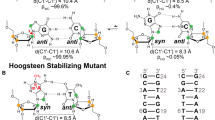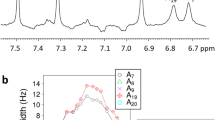Abstract
A detailed analysis of the 13C relaxation of 13C-labelled spermine bound to duplex and quadruplex DNA is presented. T1, T2 and heteronuclear NOE data were collected at four 13C frequencies (75.4, 125.7, 150.9 and 201.2 MHz). The data were analyzed in terms of a frequency-dependent order parameter, S 2(ω), to estimate the generalized order parameter and the contributions to the relaxation from different motional frequencies in the picosecond–nanosecond timescale and from any exchange processes that may be occurring on the microsecond–millisecond timescale. The relaxation data was surprisingly similar for spermine bound to two different duplexes and a linear parallel quadruplex. Analysis of the relaxation data from these complexes confirmed the conclusions of previous studies that the dominant motion of spermine is independent of the macroscopic tumbling of the DNA and has an effective correlation time of ∼50 ps. In contrast, spermine bound to a folded antiparallel quadruplex had faster relaxation rates, especially R 2. As with the other complexes, a fast internal motion of the order of 50 ps makes a substantial contribution to the relaxation. The generalized order parameter for spermine bound to duplex DNA and the linear quadruplex is small but is larger for spermine bound to the folded quadruplex. In the latter case, there is evidence for exchange between at least two populations of spermine occurring on the microsecond–millisecond timescale.





Similar content being viewed by others
References
Aboul-ela F, Murchie AIH, Lilley DMJ (1992) NMR study of parallel-stranded tetraplex formation by the hexadeoxynucleotide d(TG4T). Nature 360:280–282
Andreasson B, Nordenskiöld L, Braunlin WH (1996) An NMR self-diffusion study of the interactions between spermidine and oligonucleotides. Biopolymers 38:505–513
Bancroft D, Williams LD, Rich A, Egli M (1994) The low-temperature crystal structure of the pure-spermine form of Z-DNA reveals binding of a spermine molecule in the minor groove. Biochemistry 33:1073–1086
Banville DL, Feuerstein BG, Shafer RH (1991) 1H and 31P nuclear magnetic resonance studies of spermine binding to the Z-DNA form of d(m5CGm5CGm5CG)2: evidence for decreased spermine mobility. J Mol Biol 219:585–590
Bello-Fernandez C, Packham G, Cleveland JL (1993) The ornithine decarboxylase gene is a transcriptional target of c-Myc. Proc Natl Acad Sci USA 90:7804–7808
Berchtold CM, Tamez P, Kensler TW, Casero RA Jr (1998) Inhibition of cell growth in CaCO2 cells by the polyamine analog N 1 -N 12-bis(ethyl)spermine is preceded by a reduction in MYC oncoprotein levels. J Cell Physiol 174:380–386
Brüne B, Hartzell P, Nicotera P, Orrenius S (1991) Spermine prevents endonuclease activation and apoptosis in thymocytes. Exp Cell Res 195:323–329
Clore GM, Szabo A, Bax A, Kay LE, Driscoll PC, Gronenborn AM (1990) Deviations from the simple two-parameter model-free approach to the interpretation of nitrogen-15 nuclear magnetic relaxation of proteins. J Am Chem Soc 112:4989–4991
Dai JX, Chen D, Jones RA, Hurley LH, Yang DZ (2006) NMR solution structure of the major G-quadruplex structure formed in the human BCL2 promoter region. Nucleic Acids Res 34:5133–5144
Dexheimer TS, Sun D, Hurley LH (2006) Deconvoluting the structural and drug-recognition complexity of the G-quadruplex-forming region upstream of the bcl-2 P1 promoter. J Am Chem Soc 128:5404–5415
Douki T, Bretonniere Y, Cadet J (2000) Protection against radiation-induced degradation of DNA bases by polyamines. Radiat Res 153:29–35
Drew HR, Wing RM, Takano T, Broka C, Tanaka S, Itakura K, Dickerson RE (1981) Strucuture of a B-DNA dodecamer. Conformation and dynamics. Proc Natl Acad Sci USA 78:2179–2183
Egli M, Tereshko V, Teplova M, Minasov G, Joachimiak A, Sanishvili R, Weeks CM, Miller R, Maier MA, An H et al (1998) X-ray crystallographic analysis of the hydration of A- and B-form DNA at atomic resolution. Biopolymers 48:234–252
Farrow NA, Muhandiram R, Singer AU, Pascal SM, Kay CM, Gish G, Shoelson SE, Pawson T, Forman-Kay JD, Kay LE (1994) Backbone dynamics of a free and a phosphopeptide-complexed Src homology 2 domain studied by 15N NMR relaxation. Biochemistry 33:5984–6003
Gray BN, Owen EA, Keniry MA (1994) The solution conformation of a trisdecanucleotide containing the consensus binding site of the dnaA initiation protein. Eur J Biochem 226:115–124
Hurley LH (2001) Secondary DNA structures as molecular targets for cancer therapeutics. Biochem Soc Trans 29:692–696
Idiyatullin D, Daragan VA, Mayo KH (2003) Protein dynamics using frequency-dependent order parameters from analysis of NMR relaxation data. J Magn Reson 161:118–125
Israel M, Rosenfield JS, Modest EJ (1964) Analogs of spermine and spermidine. I. Synthesis of polymethylenepolyamines by reduction of cyanoethylated α,ω-alkylenediamines. J Med Chem 7:710–716
Jain S, Zon G, Sundaralingan M (1989) Base only binding of spermine in the deep groove of the A-DNA octamer d(GTGTACAC). Biochemistry 28:2360–2364
Jin C, Prompers JJ, Brüschweiler R (2003) Cross-correlation suppressed T1 and NOE experiments for protein side-chain 13CH2 groups. J Biomol NMR 26:241–247
Keniry MA (2001) Quadruplex structures in nucleic acids. Biopolymers 56:123–146
Keniry MA (2003) A comparison of the association of spermine with duplex and quadruplex DNA by NMR. FEBS Lett 542:153–158
Korolev N, Lyubartsev AP, Nordenskiöld L, Laaksonen A (2001) Spermine: an “invisible” component in the crystals of B-DNA. A grand canonical Monte Carlo and molecular dynamics simulation study. J Mol Biol 308:907–917
Korolev N, Lyubartsev AP, Laaksonen A, Nordenskiöld L (2002) On the competition between water, sodium ions, and spermine in binding to DNA: a molecular dynamics computer simulation study. Biophys J 82:2860–2875
Lewis JS, Thomas TJ, Shirahata A, Thomas T (2000) Self-assembly of an oligodeoxyribonucleotide harboring the estrogen response element in the presence of polyamines: ionic, structural and DNA sequence specificity effects. Biomacromolecules 1:339–349
Lindemose S, Nielsen PF, Møllegaard NE (2005) Polyamines preferentially interact with bent adenine tracts in double-stranded DNA. Nucleic Acids Res 33:1790–1803
Lipari G, Szabo A (1982) Model-free approach to the interpretation of nuclear magnetic relaxation in macromolecules. 1. Theory and range of validity. J Am Chem Soc 104:4546–4559
Liquori AM, Constantino L, Crescenzi V, Elia V, Giglio E, Puliti R, De Santis Savino M, Vitagliano V (1967) Complexes between DNA and polyamines: a molecular model. J Mol Biol 24:113–122
Marsh AJ, Williams DM, Grasby JA (2004) The synthesis and properties of oligoribonucleotide-spermine conjugates. Org Biomol Chem 2:2103–2112
Marton LJ, Pegg AE (1995) Polyamines as targets for therapeutic intervention. Annu Rev Pharmacol Toxicol 35:55–91
Ohishi H, Terasoma N, Nakanishi I, van der Marel G, Van Boom JH, Rich A, Wang AHJ, Hakoshima T, Tomita K (1996) Interaction between left-handed Z-DNA and polyamine. 3. The crystal structure of the d(CG)3 and thermospermine complex. FEBS Lett 398:291–296
Ouameur AA, Tajmir-Riahi H-A (2004) Strucutural analysis of DNA interactions with biogenic polyamines and cobalt(III)hexamine studied by fourier transform infrared and capillary electrophoresis. J Biol Chem 279:42041–42054
Palmer III AG, Rance M, Wright PE (1991) Intramolecular motions of a zinc finger DNA-binding domain from Xfin characterized by proton-detected natural abundance 13C heteronuclear spectroscopy. J Am Chem Soc 113:4371–4380
Phillips K, Dauter Z, Murchie AIH, Lilley DMJ, Luisi B (1997) The crystal structure of a parallel-stranded guanine tetraplex at 0.95Å resolution. J Mol Biol 273:171–182
Quigley GJ, Teeter MM, Rich A (1978) Structural analysis of spermine and magnesium-ion binding to yeast phenylalanine transfer-RNA. Proc Natl Acad Sci USA 75:64–68
Ruiz-Chica J, Medina MA, Sánchez-Jiménez F, Ramírez FJ (2001) Fourier transform Raman study of the structural specificities on the interaction between DNA and biogenic polyamines. Biophys J 80:443–454
Schmid N, Behr J-P (1991) Location of spermine and other polyamines on DNA as revealed by photoaffinity cleavage with poly(amino)benzenediazonium salts. Biochemistry 30:4357–4361
Shafer RH, Smirnov I (2001) Biological aspects of DNA/RNA quadruplexes. Biopolymers 56:209–227
Siddiqui-Jain A, Grand CL, Bearss DJ, Hurley LH (2002) Direct evidence for a G-quadruplex in a promotor region and its targeting with a small molecule to repress c-Myc transcription. Proc Natl Acad Sci USA 99:11593–11598
Smith FW, Feigon J (1992) Quadruplex structure of Oxytricha telomeric DNA oligonucleotides. Nature 356:164–168
Sun DY, Guo KX, Rusche JJ, Hurley LH (2005) Facilitation of a structural transition in the polypurine/polypyrimidine tract within the proximal promoter region of the human VEGF gene by the presence of potassium and G-quadruplex-interactive agents. Nucleic Acids Res 33:6070–6080
Tabor CW, Tabor H (1984) Polyamines. Annu Rev Biochem 53:749–790
Thomas T, Thomas TJ (1993) Selectivity of polyamines in triplex DNA stabilization. Biochemistry 32:14068–14074
Thomas T, Thomas TJ (2001) Polyamines in cell growth and cell death: Molecular mechanisms and therapeutic applications. Cell Mol Life Sci 58:244–258
Thomas TJ, Gunnia UB, Thomas T (1991) Polyamine-induced B-DNA to Z-DNA conformational transition of a plasmid DNA with (dG-dC)N insert. J Biol Chem 266:6137–6141
Thomas T, Kulkarni GD, Gallo MA, Greenfield N, Lewis JS, Shirahata A, Thomas TJ (1997) Effects of natural and synthetic polyamines on the conformation of an oligodeoxyribonucleotide with the estrogen response element. Nucleic Acids Res 25:2396–2402
Tippin DB, Sundaralingam M (1997) Nine polymorphic crystal structures of d(CCGGGCCCGG), d(CCGGGCCm5CGG), d(Cm5CGGGCCm5CGG) and d(CCGGGCC(Br)5CGG) in three different conformations: effects of spermine binding and methylation on the bending and condensation of A-DNA. J Mol Biol 267:1171–1185
Van Dam L, Nordenskiöld L (1999) Interactions of polyamines with the DNA octamers d(m5CG)4 and d(GGAATTCC): a 1H-NMR investigation. Biopolymers 49:41–53
Wang AH-J, Quigley GJ, Kolpak FJ, Crawford JL, Van Boom JH, Marel GVDM, Rich A (1979) Molecular structure of a left-handed double helical DNA fragment at atomic resolution. Nature 282:680–686
Wemmer DE, Srivenugopal KS, Reid BR, Morris DR (1985) Nuclear magnetic resonance studies of polyamine binding to a defined DNA sequence. J Mol Biol 185:457–459
Acknowledgments
This work benefited from the use of NMR facilities at the Australian National University. The authors wish to thank Mr. Rob Longmore for the synthesis of the 13C-spermine, Kylie Clayton for technical assistance, Dr. Michael John for advice on Mathematica programming and Professor Richard Shafer for critical reading of the manuscript.
Author information
Authors and Affiliations
Corresponding author
Electronic supplementary material
Below is the link to the electronic supplementary material.
Rights and permissions
About this article
Cite this article
Keniry, M.A., Owen, E.A. An investigation of the dynamics of spermine bound to duplex and quadruplex DNA by 13C NMR spectroscopy. Eur Biophys J 36, 637–646 (2007). https://doi.org/10.1007/s00249-007-0136-4
Received:
Revised:
Accepted:
Published:
Issue Date:
DOI: https://doi.org/10.1007/s00249-007-0136-4




